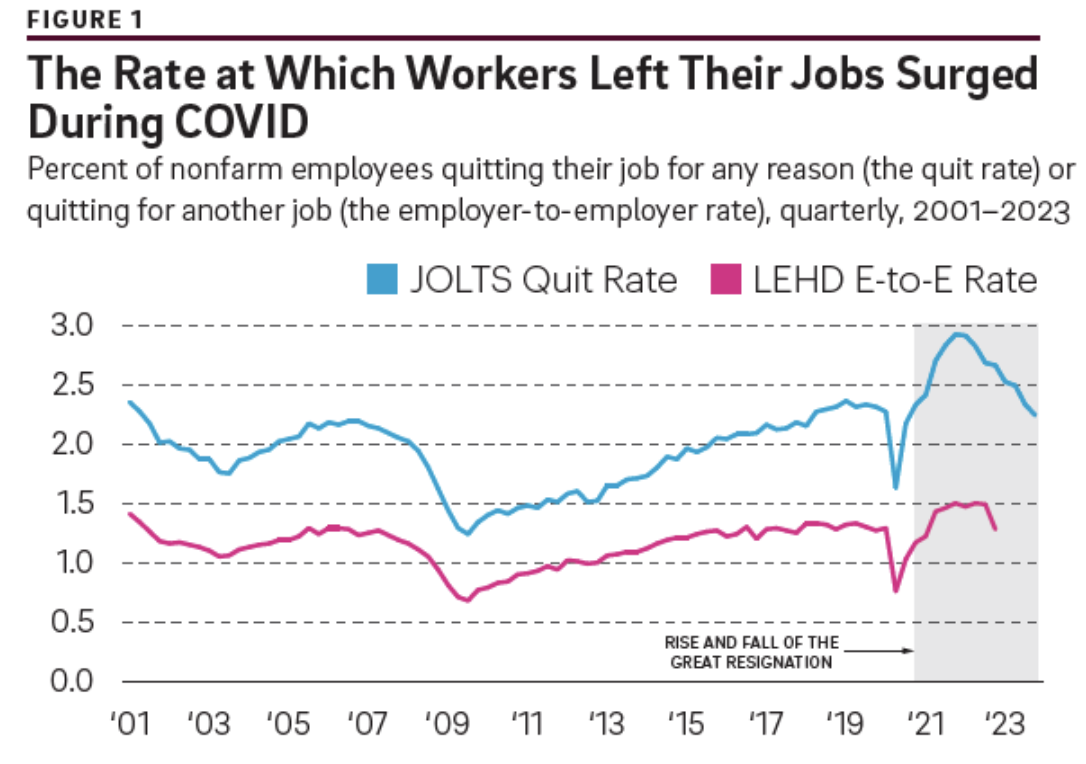Comments
- No comments found

The “Great Resignation” refers to a rise in the rate at which people were quitting their jobs starting in late 2021.
It may look like much on a graph. This graph shows the monthly rate at which workers quit jobs voluntarily (thus, not counting retirements, health issues, or being laid off). You can see the blue line peaking at 3% per month, which if you work out the arithmetic, would mean that over a 12-month period, a number of workers equal to 40% of the entire workforce would have quit their job. You can also see a gradually rising “quit rate” from the end of the Great Recession in 2009.

Ryan Michaels lays out three possible explanations in “What Explains the Great Resignation?” (Economic Insights: Federal Reserve Bank of Philadelphia, 2024: Q2, pp. 10-18).
In the graph above, the blue line is a “quit rate” calculated from the Job Openings and Labor Turnover (JOLTS) Survey, which is a survey of 21,000 establishments. The red line is data from the Longitudinal Employer and Household Dynamics (LEHD) data set, which includes nearly all workers and firms, but only comes out quarterly rather than monthly. An advantage of the LEHD is that you can track whether someone switches directly from one employer to another: a disadvantage is that you don’t know in the LEHD data if the worker quit voluntarily to take another job, or was laid-off and just found another job very quickly.
Michaels suggests three reasons why the quit rate may have risen:
According to the fast-growth narrative, the rise in quits was a byproduct of the fast economic recovery in 2021–2022. According to the telework narrative, quits rose because more workers transitioned to remote-work occupations. And according to the wealth narrative, the sharp increase in household savings during the pandemic enabled workers to spend more time away from paid work, and thereby induced quits.
After breaking down the labor market movements by industry and demographic groups, Michaels concludes:
Higher quit rates were observed for all industries and demographic groups, but the rise in quits was particularly sharp for younger, female, nonwhite, and non-college-educated workers. Many of these workers transitioned directly to another employer, but a majority left the workforce altogether. This suggests that changes in both the supply of labor (as illustrated by the wealth narrative) and the demand (as illustrated by the fast-growth narrative) contributed to the rise in quits. … The rise in quits was fueled by both stronger labor demand and weaker labor supply—a combination that should put upward pressure on wages. The acceleration in wage inflation appears to have in turn fed into higher price inflation.
Timothy Taylor is an American economist. He is managing editor of the Journal of Economic Perspectives, a quarterly academic journal produced at Macalester College and published by the American Economic Association. Taylor received his Bachelor of Arts degree from Haverford College and a master's degree in economics from Stanford University. At Stanford, he was winner of the award for excellent teaching in a large class (more than 30 students) given by the Associated Students of Stanford University. At Minnesota, he was named a Distinguished Lecturer by the Department of Economics and voted Teacher of the Year by the master's degree students at the Hubert H. Humphrey Institute of Public Affairs. Taylor has been a guest speaker for groups of teachers of high school economics, visiting diplomats from eastern Europe, talk-radio shows, and community groups. From 1989 to 1997, Professor Taylor wrote an economics opinion column for the San Jose Mercury-News. He has published multiple lectures on economics through The Teaching Company. With Rudolph Penner and Isabel Sawhill, he is co-author of Updating America's Social Contract (2000), whose first chapter provided an early radical centrist perspective, "An Agenda for the Radical Middle". Taylor is also the author of The Instant Economist: Everything You Need to Know About How the Economy Works, published by the Penguin Group in 2012. The fourth edition of Taylor's Principles of Economics textbook was published by Textbook Media in 2017.
Leave your comments
Post comment as a guest